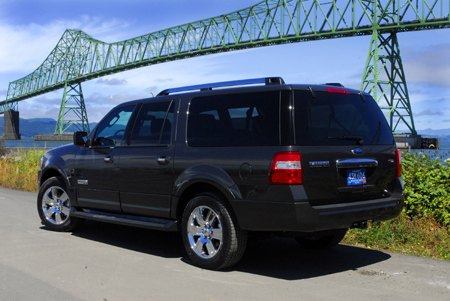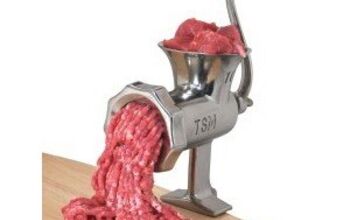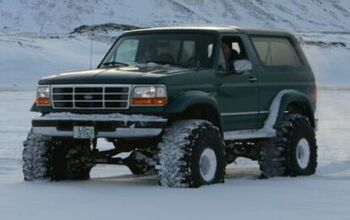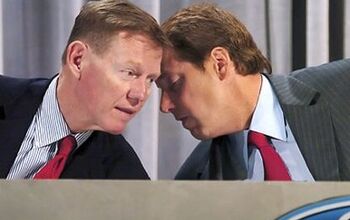Ford Death Watch 4: Death by a Thousand Cuts
Last Friday, Ford announced its largest production cuts in over two decades. The bold (not to say unavoidable) move comes in the face of evaporating truck sales; even large discounts on the formerly formidable F150 and Explorer can't move the metal faster than it's being built. With a debt rating that’s sleeping with the fishes, with the company’s “Way Forward” recovery plan in triage, with another disastrous quarter only days away, Ford is looking increasingly, irredeemably desperate.
The cutbacks are large in both scope and scale. Ford’s rolling production blackouts will hit ten assembly plants in total. The Blue Oval Boys will reduce output by some 21% for this year’s final financial quarter, shrinking total vehicle production to just over three million vehicles for the year (roughly nine percent behind ‘05 totals). Ford truck plants will fare the worst, losing 404k units from previous annual output targets.
That's not good. Last year, Ford’s F-Series pickup trucks accounted for nearly a third of the company’s 3.2m US sales total (or more than seven times Volvo's American sales). For the first time in three years, the F-Series will not reach its sales target— not even the revised 900k mark recently put forth by embattled CEO Mark Fields. With over 270k units depreciating on dealer lots, America’s best selling truck will bear the brunt of at least half of the cuts.
No matter how you look at it, coming-up short is gonna hurt. Ford’s Michigan Truck factory was once one of the world’s most profitable production facilities; through the late 90’s, it generated some $10b in annual revenue. While Ford doesn’t divulge production costs or profit margins for its individual vehicles, analysts indicate that each F-series pickup delivered $13k in profit. The evaporating truck market has put Ford’s cash cow on the barbie, and there aren’t any newborns ready to lactate greenbacks on their behalf.
Falling revenues are only half the problem. J.P. Morgan analyst Himanshu Patel figures Ford’s decision to downsize production will cost the company $1.4b this year, and around $2.7b in 2007. The main reason: Ford’s current contract with the United Auto Workers (UAW). Idled union workers will receive a Supplemental Unemployment Benefits (SUB) package. After an initial period of partial government support, Ford will have to pay them 95% of their normal take home pay for a 40-hour work week, for not working. Union members with at least ten years’ service will still receive full employer-paid health insurance.
Looking ahead, the UAW contract also stipulates that no union worker can be laid off for more than 48 weeks due to a decline in sales or production. While it’s doubtful that production would halt for that long, the 48 weeks is cumulative for the entire four year agreement. Short term, expanding their blue collar buyout program is the only way for Ford to staunch their “death by a thousand cuts” labor cost wounds.
Unconfirmed reports indicate that Ford will put buyout offers on the table to all their hourly workers in the next week. UAW V.P. Bob King has already stated that he could convince his brothers to stay home– for the right price. But none of this will solve Ford’s cash crunch. Only an immediate series of blockbuster new products and a new, more favorable union contract can do that— neither of which is likely.
Again, there's no immediate relief on the product front. Sales of fuel-sipping B-segment cars are up 43 percent and growing. In most urban markets, Honda, Nissan and Toyota dealers can’t keep up with demand for their Fit, Versa and Yaris, which are selling at full retail or, wait for it, better. Despite finally admitting the seriousness of this market, Ford has yet to announce a B-segment buster.
Meanwhile, Ford’s desperation is there for all to see. Yesterday’s announcement that FoMoCo would follow GM’s lead and offer up to 72 months of zero percent financing to anyone with a pulse is a clear-cut indication that Ford is willing to do anything to stay in business— including cheapening the brand and mortgaging their future. Ford isn’t even trying hard to hide the fact that they’ve thrown open their doors to sub-prime borrowers. "If you were on the margin for being approved for a loan,” Ford flackmeister Jim Cain said. “You are more likely to get a loan today than you were a week ago."
The question is, is Ford more likely to avoid Chapter 11 than it was a week ago? Ford's market share is still declining rapidly– from last year's 25.7% to this year's 18.1%. The company would like you to believe that the production cuts reflect a new, new realism and demonstrate management’s courage to make difficult decisions. Which may be true. But the old maxim “You can’t cut your way to prosperity” is just as true for Ford as it is for GM and DCX. Ford is still poised for breakup, merger or bankruptcy.
More by Neunelf
Latest Car Reviews
Read moreLatest Product Reviews
Read moreRecent Comments
- Kwik_Shift_Pro4X I've mentioned before about being very underwhelmed by the Hornet for a $50000+ all in price tag. Just wasn't for me. I'd prefer a Mazda CX-5 or even a Rogue.
- MaintenanceCosts Other sources seem to think that the "electric Highlander" will be built on TNGA and that the other 3-row will be on an all-new EV-specific platform. In that case, why bother building the first one at all?
- THX1136 Two thoughts as I read through the article. 1) I really like the fins on this compared to the others. For me this is a jet while the others were propeller driven craft in appearance.2) The mention of the wider whitewalls brought to mind a vague memory. After the wider version fell out of favor I seem to remember that one could buy add-on wide whitewalls only that fit on top of the tire so the older look could be maintained. I remember they would look relatively okay until the add-on would start to ripple and bow out indicating their exact nature. Thanks for the write up, Corey. Looking forward to what's next.
- Analoggrotto It's bad enough we have to read your endless Hyundai Kia Genesis shilling, we don't want to hear actually it too. We spend good money on speakers, headphones and amplifiers!
- Redapple2 Worthy of a book


































Comments
Join the conversation
Ford just fell way behind, and doesn't seem to be able to bridge the gap in the 00's. The fit and finish of ford cars is kinda rough around the edges. Yeah I have driven them and owned them, but compaired to german cars they just don't do it. I am not a fan of GM either but I have to say the cars just run and run, without major incidents, but there are no frills cars. If ford was smart they would just come out with that concept car they had in the auto shows a while back the Model U , give you a free ipod, make it a nice hybrid and underprice honda.
Just wanted to resurrect this thread as a venue to discuss Bill Ford's resignation as CEO this afternoon. Should I be buying Ford stock? It might be a plus that Mr. Ford is stepping aside. What are the odds that an heir to Henry Ford is also the most qualified person to run such a company? Although he's been "working" at Ford since he was 22 years old, is that good or bad? What about broader exposure? Then there's his replacement, Mr. Mulally. He's also worked at the same place, Boeing, since he was a young man in 1969. Is Boeing, who splits the aircraft business with only one major rival, or does work for the government, a good training ground for an intensely competitive industry? Maybe this "One life, one job." concept is the key to success. After all, GM's Rick Wagoner started at GM right out of grad school.